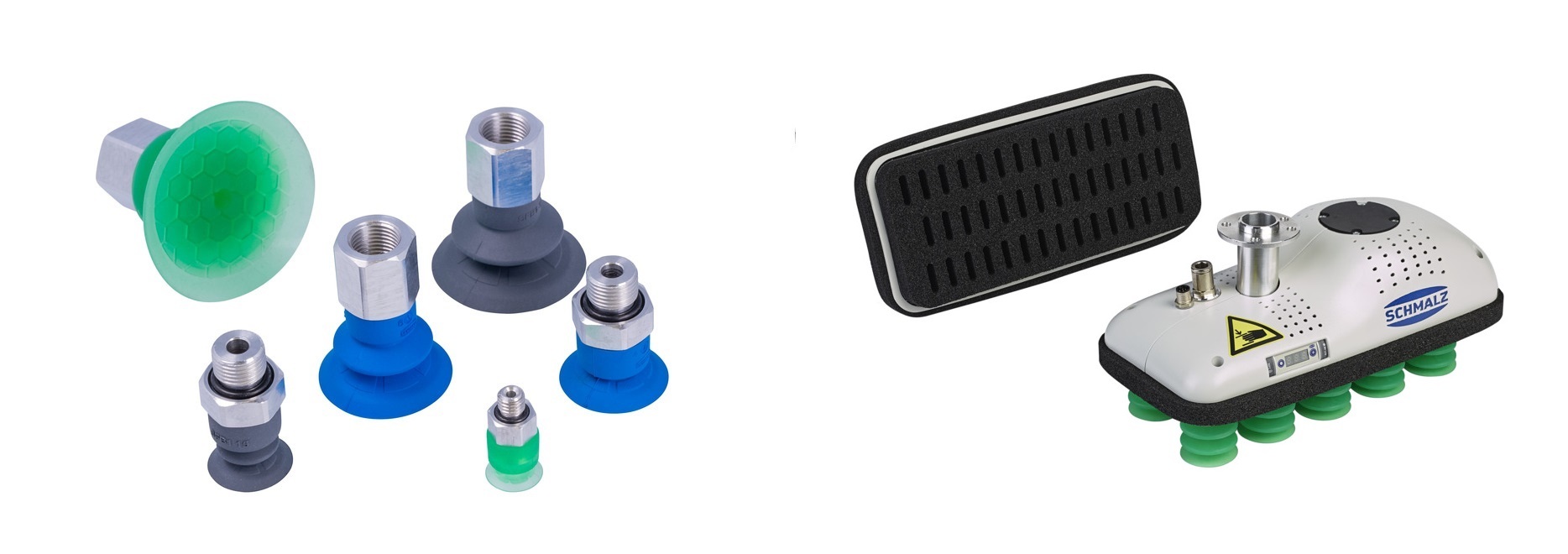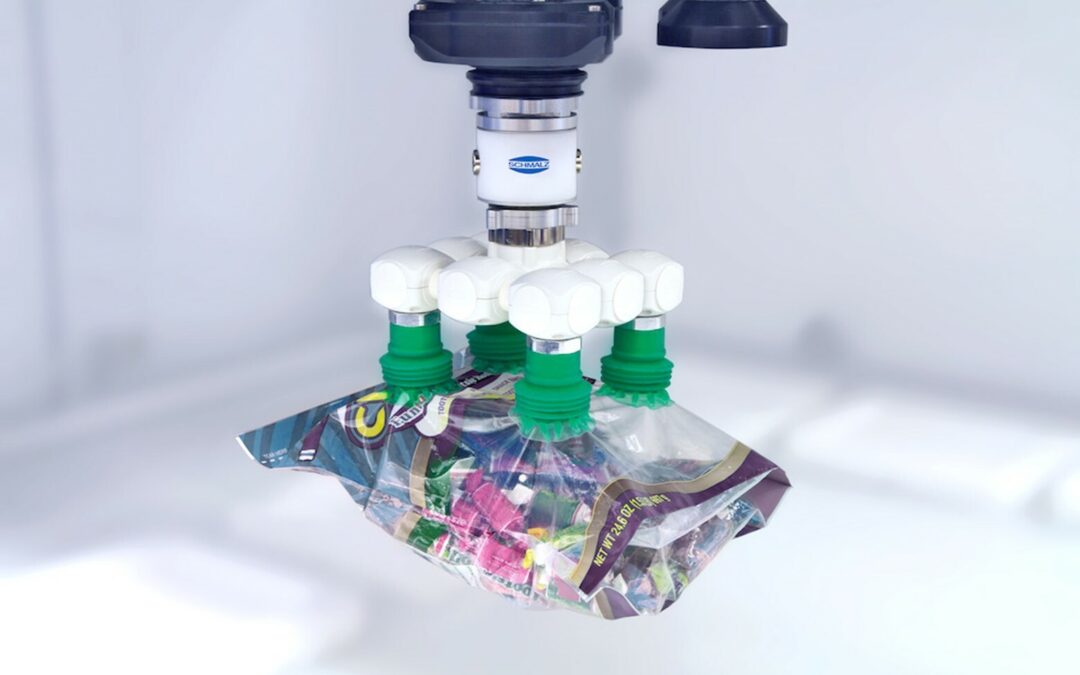In the world of manufacturing, vacuum is perhaps one of the least understood yet widely used technologies. Many consider vacuum to be a “black magic” that is difficult to size and implement correctly leading to issues caused by incorrectly sized systems. In truth, vacuum systems may be more complicated than other types of pneumatic systems, however with the right system, vacuum is best suited for countless automation processes across different industries, including automotive, warehousing and logistics, and food and beverage.
What is Vacuum?
Vacuum is created by removing air pressure from an enclosed area. This vacuum creates a negative pressure zone, causing the surrounding air pressure to push on the area of the vacuum, which results in a pulling force on the object. This is the same principle that allows a drinking straw to convey fluid up through it. This force can be calculated by multiplying the area of the surface under vacuum by the pressure difference between the vacuum system and the outside air. In fact, this is a very similar formula to the one used to calculate the force of a pneumatic cylinder, with the only difference being negative pressure instead of positive.

By removing air from inside a suction cup, the surrounding air pressure pushes on the part and workpiece, pulling the workpiece into the suction cup. Photo from physics.stackexchange.com
How is Vacuum Created?
Vacuum is created by displacing the positive pressure in a system out through an exhaust. This can be achieved either by using pneumatic or electric vacuum generators. The most common type of pneumatic vacuum generators is called venturi generators. These use a compressed air supply to take advantage of a phenomenon called the venturi effect, in which air is passed through a small diameter nozzle, creating a very high-speed stream of air. This stream pulls the air out of the vacuum system, creating negative pressure. Venturi generators are widely used in automation as they are low cost, simple to maintain, and can be easily tied into existing pneumatic systems. The drawback to venturi generators, however, is that they are generally limited to applications that require lesser amounts of flow such as on nonporous surfaces (glass and metal), where a good vacuum seal can be made. In applications where greater flow is required such as heavy, porous objects (heavy bags or cardboard boxes), electric vacuum generators tend to be a better option.
Electric vacuum generators, such as regenerative blowers, vane pumps, and claw pumps are powered with an electric motor, that drives either a turbine, vane, or claw system respectively. Rotational motion pushes air out of the system, creating a vacuum on the other end similar to how a household vacuum cleaner works. These systems have several advantages over venturi generators. For applications requiring higher amounts of vacuum flow, such as palletizing a full pallet layer of cardboard boxes at a time, electric generators tend to be more efficient due to the massive amount of compressed airflow that a similarly sized venturi system would require. Additionally, since the system does not require an air compressor, the vacuum performance is not affected by fluctuating compressed air demands. Smaller electric vacuum generators are also a great option for collaborative robots that may not have access to a plumbed compressed air supply. Drawbacks to electric vacuum generators, however, include a higher upfront cost that the units typically demand over venturis as well as the increased maintenance they require due to having moving parts. Larger vacuum generators also typically require 240V or 480V three phase power, something that must be considered when designing large vacuum applications such as robot cells.

A venturi generator (left) uses a compressed air supply to create a phenomenon called the Venturi Effect, where air from the bottom port is pulled in with the rest, creating a vacuum with no moving parts. A vane style generator (right) uses an electric motor to spin vanes very quickly, pulling air into an inlet and creating vacuum. Photos from Schmalz.com and Encyclopedia Britannica respectively.
How Do You Grip Objects Using Vacuum??
While selecting the correct type of vacuum generator is important to the success of a system, it is useless without the proper means to secure and move an object. Vacuum grippers come in many different shapes and sizes for a wide range of different applications.
Suctions Cups
Suction cups are generally the most common style of vacuum grippers. These are typically round or oval-shaped and made of soft rubber or polymer that acts as a sealing surface for the vacuum, with the internal area of the cup determining the amount of holding force the suction cup has. A great deal of engineering goes into designing a cup for a specific application. For example, a suction cup used to pick oily sheet metal may have texturing on the inside diameter of the cup to allow for increased grip on a slippery surface while cups meant for moving packaging may utilize a softer lip to allow for better sealing on cardboard. Material selection is also often critical when selecting the right cup for an application. For example, vacuum cups in direct contact with food must abide by FDA guidelines, requiring they be made of silicone and have metal particles in them to set off metal detectors should they find their way into food products. Vacuum cups working with electronics may be required to be made of a material that protects sensitive electronics from electrostatic discharge (ESD) that may otherwise ruin the part.
Area Grippers
Besides vacuum cups, area grippers are another common type of gripping solution. These consist of a flat metal plate that includes either an array of vacuum cups or a foam pad, effectively turning the entire area of the plate into one giant vacuum system. Area grippers are commonly used in packaging and wood handling applications, as they can pick multiple items at once and in any orientation. Area grippers come in many different shapes and sizes, from small iPhone-sized grippers meant for collaborative robots to full layer palletizer grippers designed to grab an entire pallet layer of product at once.

An assortment of vacuum cups (left) meant for a variety of different applications. An area gripper (right) with both foam pad and vacuum cup options shown. Photos from Schmalz.com
How to Get Started
With so many variables to consider, designing a vacuum system and specifying the appropriate vacuum components can be a daunting task. If on your own, one of the best places to begin when starting a vacuum project is to look at use cases to find what others have done for similar applications. A YouTube video can go a long way to giving insight into what has worked for others. The next step is to outline the scope of what the system will need to accomplish. How heavy is the part being moved? Is it a smooth, sealable surface, or is it porous? Will the application require the part to be picked up vertically or move at high speeds? Are there any environmental or regulatory factors that must be considered such as high heat or FDA regulations? All these factors (and more) must be considered. Once the scope of the application is outlined, the correct grippers and vacuum generators must be sized for the application. Online tools like Schmalz’s Vacuum Caslculator are a great asset, providing theoretical values of lifting force, evacuation time, and correct hose diameter at the click of a button.
You don’t have to navigate the complexities of Vacuum Systems alone
There is an even better option than going it alone in evaluating the effectiveness of a vacuum system. Contact the experts at EFP for local support and service combined with the leading engineering and expertise of leading global vacuum systems manufacturers. Let EFP Industrial Automation be your partner in deploying vacuum systems solutions!

